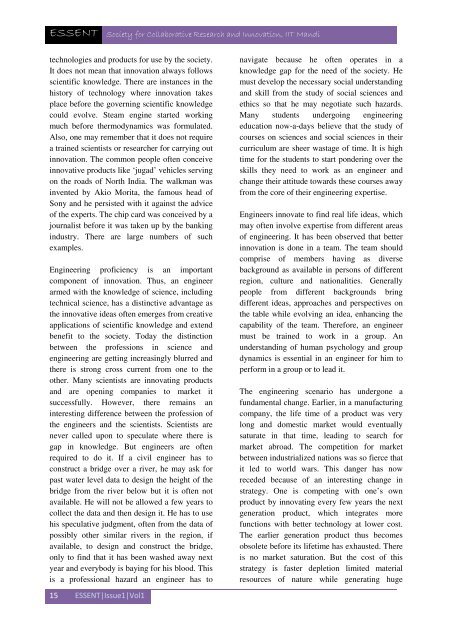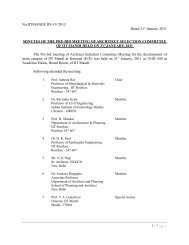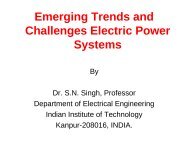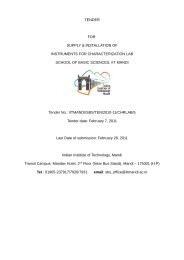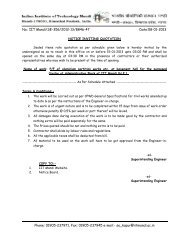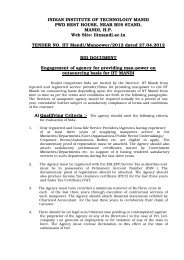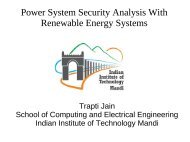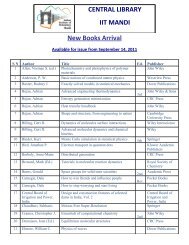Issue1. Vol.1 (April, 2013) - IIT Mandi
Issue1. Vol.1 (April, 2013) - IIT Mandi
Issue1. Vol.1 (April, 2013) - IIT Mandi
- No tags were found...
You also want an ePaper? Increase the reach of your titles
YUMPU automatically turns print PDFs into web optimized ePapers that Google loves.
ESSENT Society for Collaborative Research and Innovation, <strong>IIT</strong> <strong>Mandi</strong>technologies and products for use by the society.It does not mean that innovation always followsscientific knowledge. There are instances in thehistory of technology where innovation takesplace before the governing scientific knowledgecould evolve. Steam engine started workingmuch before thermodynamics was formulated.Also, one may remember that it does not requirea trained scientists or researcher for carrying outinnovation. The common people often conceiveinnovative products like ‘jugad’ vehicles servingon the roads of North India. The walkman wasinvented by Akio Morita, the famous head ofSony and he persisted with it against the adviceof the experts. The chip card was conceived by ajournalist before it was taken up by the bankingindustry. There are large numbers of suchexamples.Engineering proficiency is an importantcomponent of innovation. Thus, an engineerarmed with the knowledge of science, includingtechnical science, has a distinctive advantage asthe innovative ideas often emerges from creativeapplications of scientific knowledge and extendbenefit to the society. Today the distinctionbetween the professions in science andengineering are getting increasingly blurred andthere is strong cross current from one to theother. Many scientists are innovating productsand are opening companies to market itsuccessfully. However, there remains aninteresting difference between the profession ofthe engineers and the scientists. Scientists arenever called upon to speculate where there isgap in knowledge. But engineers are oftenrequired to do it. If a civil engineer has toconstruct a bridge over a river, he may ask forpast water level data to design the height of thebridge from the river below but it is often notavailable. He will not be allowed a few years tocollect the data and then design it. He has to usehis speculative judgment, often from the data ofpossibly other similar rivers in the region, ifavailable, to design and construct the bridge,only to find that it has been washed away nextyear and everybody is baying for his blood. Thisis a professional hazard an engineer has tonavigate because he often operates in aknowledge gap for the need of the society. Hemust develop the necessary social understandingand skill from the study of social sciences andethics so that he may negotiate such hazards.Many students undergoing engineeringeducation now-a-days believe that the study ofcourses on sciences and social sciences in theircurriculum are sheer wastage of time. It is hightime for the students to start pondering over theskills they need to work as an engineer andchange their attitude towards these courses awayfrom the core of their engineering expertise.Engineers innovate to find real life ideas, whichmay often involve expertise from different areasof engineering. It has been observed that betterinnovation is done in a team. The team shouldcomprise of members having as diversebackground as available in persons of differentregion, culture and nationalities. Generallypeople from different backgrounds bringdifferent ideas, approaches and perspectives onthe table while evolving an idea, enhancing thecapability of the team. Therefore, an engineermust be trained to work in a group. Anunderstanding of human psychology and groupdynamics is essential in an engineer for him toperform in a group or to lead it.The engineering scenario has undergone afundamental change. Earlier, in a manufacturingcompany, the life time of a product was verylong and domestic market would eventuallysaturate in that time, leading to search formarket abroad. The competition for marketbetween industrialized nations was so fierce thatit led to world wars. This danger has nowreceded because of an interesting change instrategy. One is competing with one’s ownproduct by innovating every few years the nextgeneration product, which integrates morefunctions with better technology at lower cost.The earlier generation product thus becomesobsolete before its lifetime has exhausted. Thereis no market saturation. But the cost of thisstrategy is faster depletion limited materialresources of nature while generating huge15 ESSENT|Issue1|Vol1


